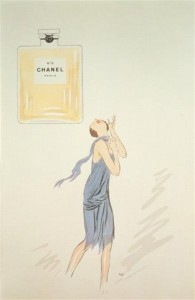From Mourning to Evening, How Coco Chanel Became Irreplaceable in the Fashion Industry
Coco Chanel’s iconic fashion sense was born of the idea that “In order to be irreplaceable one must always be different.” Her timeless, signature look, the little black dress accented with the perfect accessories like multiple strands of pearls, certainly is irreplaceable in any woman’s wardrobe. Not only was that signature look “different,” but Chanel herself was cut from a different cloth in both fashion and business senses. A true iconoclast, Chanel threw traditional women’s attire out the window and expanded fashion house offerings to include handbags, accessories and fragrance, which designers had never before offered.
 Women’s fashion—designed almost exclusively by men at the time—kept women boned into corsets and tightly bound in their gowns. Chanel was designing and selling hats in a business financed by one of her wealthy male consorts when she designed her first commercial success, a dress fashioned from jersey for a chilly French day. As friends inquired where she had purchased the piece, Chanel reportedly offered to make one for them.
Women’s fashion—designed almost exclusively by men at the time—kept women boned into corsets and tightly bound in their gowns. Chanel was designing and selling hats in a business financed by one of her wealthy male consorts when she designed her first commercial success, a dress fashioned from jersey for a chilly French day. As friends inquired where she had purchased the piece, Chanel reportedly offered to make one for them.
Chanel–long considered one of the founding mothers of fashion and most influential women of modern time–was born on the wrong side of the blanket in 1883 Saumur, France, to parents with little to offer her. Her mother died when she was only 12 years old, and her traveling-salesman father placed her in a convent orphanage where she learned to sew.
During the 1920’s Chanel launched a fragrance line with Chanel No. 5, becoming the first fashion designer to do so. Chanel once said that perfume “is the unseen, unforgettable, ultimate accessory of fashion. . . . that heralds your arrival and prolongs your departure,” a sentiment shared by women around the world as they dab fragrance behind ears and between breasts before heading out the door each day.
Chanel introduced her first suit for women in 1925, fashioned after a traditional man’s look. Sans collar and with a fitted skirt, the Chanel suit became an instant sensation, different from anything else at the time. Her little black dress turned eveningwear on its end by taking a color traditionally known for mourning and reintroducing it as elegant for evening.
As her professional life was blooming, the dark pall of World Wars and the Great Depression decended upon Chanel’s business. Her personal life and a relationship with a German military officer during World War II prompted Chanel to close her business and retire for decades, re-emerging in 1954 to begin designing a new round of classic ensembles including the Chanel jacket that would grace the frames of such powerful women as Jackie Kennedy and Marilyn Monroe. What woman wouldn’t want to seize the opportunity to reinvent herself at 70!
Chanel, who was often linked to wealthy, powerful men, never married. She chose, instead, to live freely and true to her own dreams and style. Dedication to her craft contributed greatly to the timelessness and longevity of Chanel’s creations. Although Coco Chanel died in 1971, Chanel fashion house lives on with designer Karl Lagerfeld as chief designer since 1983.

In the words of Coco Chanel…
- Fashion is not something that exists in dresses only. Fashion is in the sky, in the street, fashion has to do with ideas, the way we live, what is happening.
- A girl should be two things: classy and fabulous.
- The most courageous act is still to think for yourself. Aloud.
- Nature gives you the face you have at twenty; it is up to you to merit the face you have at fifty.
- Hard times arouse a distinctive desire for authenticity.
- In order to be irreplaceable one must always be different.
- Success is often achieved by those who don’t know that failure is inevitable.
- Don’t spend time beating on a wall, hoping to transform it into a door.
 Interviewer Interview Prep
Interviewer Interview Prep Impactful Mentees
Impactful Mentees Benefits of a Mentor
Benefits of a Mentor Advice for First-Time Managers
Advice for First-Time Managers Overcoming the 18-month Itch
Overcoming the 18-month Itch Dressing for Your Style
Dressing for Your Style Interview Style Tips
Interview Style Tips Women's Stocking Stuffers
Women's Stocking Stuffers Gift the Busy Traveler
Gift the Busy Traveler Father’s Day Gift Guide
Father’s Day Gift Guide Airport Layover Activities
Airport Layover Activities Traveling & Eating Healthy
Traveling & Eating Healthy Travel Like a Boss Lady
Travel Like a Boss Lady The Dual California Life
The Dual California Life Gifts for Thanksgiving
Gifts for Thanksgiving Summer Reading List
Summer Reading List Top Leisurely Reads
Top Leisurely Reads New Year, New Books
New Year, New Books Life Lessons from a Sitcom
Life Lessons from a Sitcom Oprah, Amy or Amal?
Oprah, Amy or Amal?






